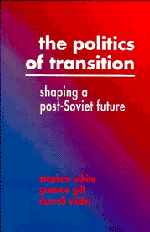Book contents
- Frontmatter
- Contents
- Preface
- 1 Beyond Marxism
- 2 Reforming the electoral system
- 3 Structures of government
- 4 The Presidency and central government
- 5 From union to independence
- 6 Patterns of republic and local politics
- 7 The withering away of the party
- 8 The emergence of competitive politics
- 9 The politics of economic interests
- 10 Public opinion and the political process
- 11 Letters and political communication
- 12 The Soviet transition and ‘democracy from above’
- Notes
- Index
5 - From union to independence
Published online by Cambridge University Press: 27 August 2009
- Frontmatter
- Contents
- Preface
- 1 Beyond Marxism
- 2 Reforming the electoral system
- 3 Structures of government
- 4 The Presidency and central government
- 5 From union to independence
- 6 Patterns of republic and local politics
- 7 The withering away of the party
- 8 The emergence of competitive politics
- 9 The politics of economic interests
- 10 Public opinion and the political process
- 11 Letters and political communication
- 12 The Soviet transition and ‘democracy from above’
- Notes
- Index
Summary
Despite the considerable efforts of Mikhail Gorbachev to hold the country together, in December 1991 the Soviet Union formally dissolved into fifteen independent states. In part this occurred because of the reluctance of Gorbachev and other central authorities to loosen their control over the republics, despite the rapid change in the politics of the republics brought about by the 1990 elections. Gorbachev routinely described leaders and movements in republics that sought independence as ‘separatists’ who were working against the ‘true’ interests of their people – ignoring the fact that, in many republics, the drive for independence enjoyed broad popular support. The political future of leaders in these republics would have been jeopardised if they compromised on the secession question. In the end, concessions offered by Gorbachev to preserve the union were inadequate, and the failed coup of August 1991 accelerated the process of disintegration by further discrediting central institutions.
Soviet ‘federalism’
The Soviet system, while formally federal in the configuration of fifteen republics, was actually an uneasy combination of an extremely centralised unitary state with some dispersal of power and a federal structure. The federal structure was, even outwardly, incomplete. The lack of true federalism was best exemplified by Russia, by far the largest republic, which had few of the institutions that existed in other republics. A Russian communist party was not created until 1990, and the CPSU central apparatus was responsible for overseeing developments there. Russian ministries were relatively weak appendages of central Soviet ministries.
Information
- Type
- Chapter
- Information
- The Politics of TransitionShaping a Post-Soviet Future, pp. 79 - 97Publisher: Cambridge University PressPrint publication year: 1993
